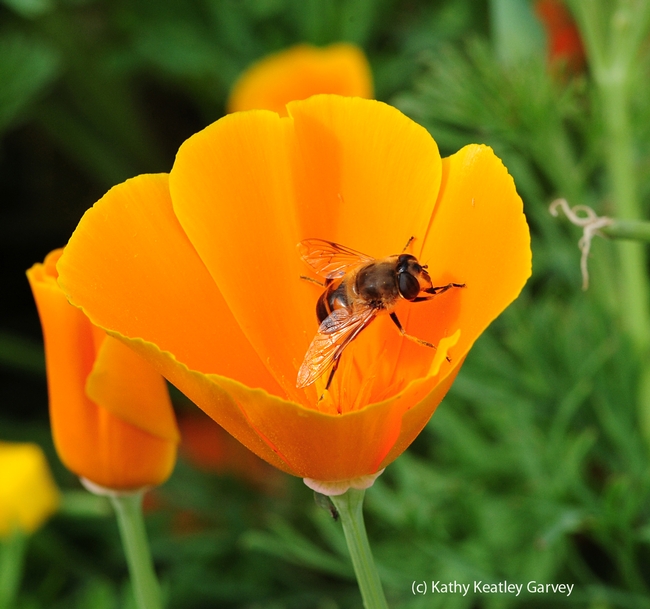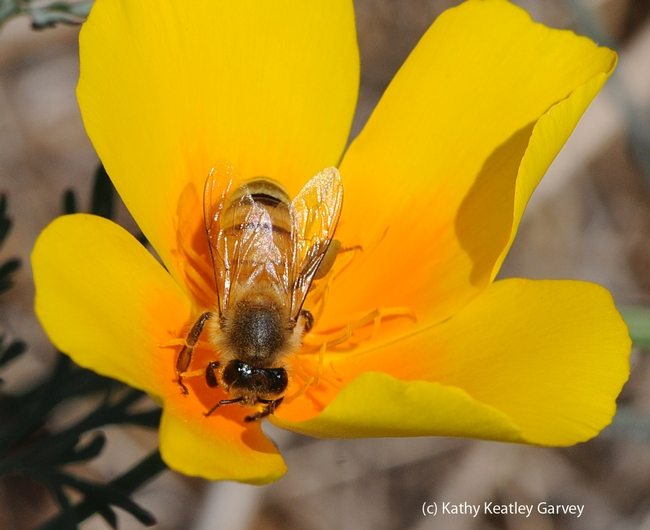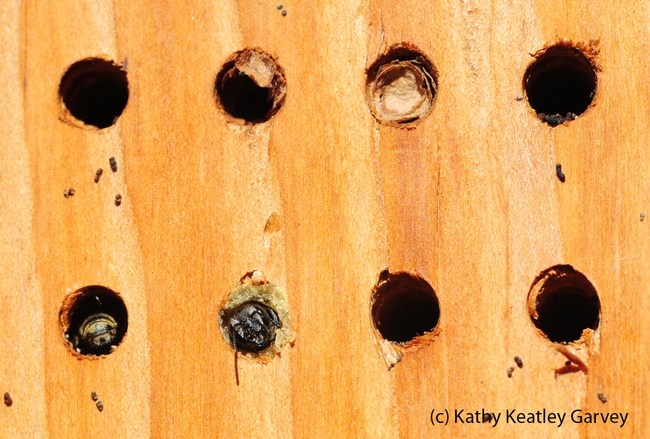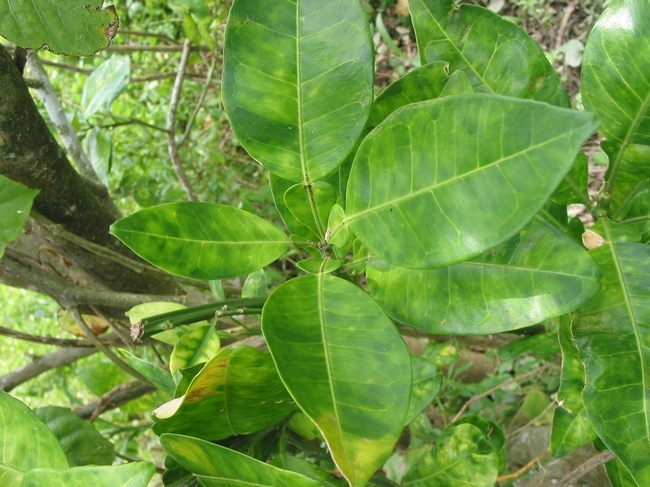UC Blogs
Pollinator Paradise
Picture a pollinator paradise right where nature intended it to be--near an apiary. Staff research associate/beekeeper Elizabeth Frost of the Harry...

Beekeeper Elizabeth Frost in front of the pollinator patch she planted. (Photo by Kathy Keatley Garvey)

Flame skimmer dragonfly rests on an unopened poppy. (Photo by Kathy Keatley Garvey)

Drone fly crawls up a petal. (Photo by Kathy Keatley Garvey)

Honey bee foraging on a California golden poppy. (Photo by Kathy Keatley Garvey)
Micronutrient deficiency can look like HLB infection
Familiarity with symptoms caused by micronutrient deficiencies is important for citrus growers and pest control advisers to ensure such maladies are not confused with symptoms of Huanglongbing, reported Cary Blake in Western Farm Press.
Neil O’Connell, UC Cooperative Extension advisor in Tulare County, a citrus expert, recommends that field staff also be well versed on these issues since they are in the field daily during the citrus harvest.
Huanglongbing, a disease spread by Asian citrus psyllid, is the worst citrus disease in the world. The disease was detected on one tree in Southern California in March, the first such find in the state. Officials are asking for farmers and home gardeners to be on the look-out for other HLB-infected trees.
O'Connell says deficiencies of zinc, iron and manganese can resemble leaf symptoms found in trees with HLB.
"Some deficiencies have fairly similar symptoms," O'Connell said. "If you are very familiar with deficiency patterns in these elements then it is much easier to separate this out. You can recognize whether the problem is zinc, iron, manganese, or another deficiency while possibly ruling out HLB."
A distinguishing characteristic of HLB infection is a yellow area that crosses from one interveinal area to another, O'Connell explained.
Horticultural Highlights of Disney
If you knew my family, you'd know that we are big fans of all things Disney. Recently, we took a trip down to Disneyland for a short family vacation. We love the rides, the atmosphere, the music, and the characters. But…my absolute favorite reason to go is to soak up the gardens!
We spent more than a fair amount of time in lines this trip, which is fine with me as it gives me more time to study the gardens. For example, while waiting for the Buzz Lightyear ride, I was able to enjoy the herb garden planted in a small raised bed. Rows of thyme, sage, basil, rosemary, and oregano. The Haunted Mansion gardens are planted with a variety of dark-colored grasses, annuals, and perennials. Pansy, Sweet William, iris, tulips, and cosmos are just some of the flowers in black, dark purple, chocolate, or burgundy that they use. Take a ride on Storybook Land and you'll find an entire garden in miniature. They even have a "quilt" done entirely in succulents. Disney parks gardens are planted in masses, rows, groups. Nothing is random.
Who hasn't gone there and noticed the huge hanging baskets of flowers? The animal topiaries around It's A Small World? Even the riot of flora and fauna along the Jungle Cruise ride is carefully planned, planted, maintained, and changed. After you start paying attention, you realize just how much detail has been tended to. Visit any other amusement park, but you will not find any with gardens that can hold a candle to those at Disney parks. Probably one of the most well-known family photo spots is the iconic Mickey Mouse head of flowers as you enter the park. That one particular icon alone requires 24,000 annuals a year!* Disney has 650 horticulturists tending the gardens of Disneyland and Disney World.* You would be surprised at how many impressive garden and landscape statistics are available that people visiting don't even consider. I own a number of books (mostly gifts!) on the gardens of Disney. They provide me with inspiration when I need it.
Someday, one of the things on my own personal "bucket list" is to visit the Epcot International Flower and Garden Festival held in Florida every spring. Until then, our family and I will continue to make the drive to Disneyland and enjoy the gardens.
*Markey, Kevin. Secrets of Disney's Glorious Gardens. New York: Disney Editions, 2006. Print.
Bed Check!
All winter long my bee condo housed 16 tenants...and one earwig. And quite comfortably, too, thank you. It all began last fall when the leafcutting...

Newly emerged leafcutter bee outside her nest. (Photo by Kathy Keatley Garvey)

One leafcutter bee is tucked in head first; the other is ready to leave. (Photo by Kathy Keatley Garvey)
Bird Poop
Chicken manure compost is an environmentally friendly and effective organic garden fertilizer. I use chicken manure to amend my soil and add usable nutrients to it at the start of the planting season. As a vegetable gardener, I treat my soil with plenty of chicken manure compost before I plant my crop in order to help provide a good start to the garden. I turn lots of chicken manure into the soil before I place my starters. After I have all the plants in the ground I add a thin layer of chicken manure to top my soil as well. I notice that applying in this fashion allows for extended release of the nutrients. In comparison with chemical fertilizers, manure is more cost effective and can be purchased inexpensively almost everywhere. Chicken manure is most preferred over steer or rabbit manure for its well rounded nutrient spectrum after it has composted and been prepared for garden use. Chicken manure is the richest variety containing the highest N-P-K ratios in comparison with other farm animal manures. Chicken manure subjectively seems to have the least amount of “odor” when compared to the other varieties making it more desirable to work with, if you will. An important tip, gardeners should only use manure that has already been composted for garden use. If the manure is not broken down and composted before use there is a very strong nitrogen content that will “burn” and can potentially damage or destroy your plants. Garden variety chicken manure is sold at all the home improvement retailers and has been composted and is ready for you to use immediately. Chicken manure will be the reason you are almost certain to have someone caught noticing your well-grown garden while asking you, “do you smell that?”

chicken


